Characteristics 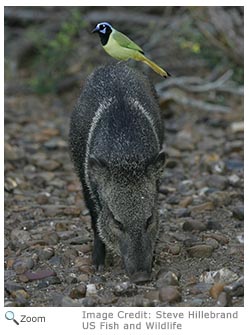 The collared peccary has a pig-like snout, a large head and shoulders and small legs with hoofed feet. It has grizzled gray and brown bristly fur. It has a collar of white or yellowish fur around its neck and small, straight tusks. It is two to three feet long and stands about one and a half feet to two feet tall. It has a musk gland at the top of its rump. It uses its musk to identify members of its group and to mark its territory. It is sometimes called the javelina. The collared peccary has a pig-like snout, a large head and shoulders and small legs with hoofed feet. It has grizzled gray and brown bristly fur. It has a collar of white or yellowish fur around its neck and small, straight tusks. It is two to three feet long and stands about one and a half feet to two feet tall. It has a musk gland at the top of its rump. It uses its musk to identify members of its group and to mark its territory. It is sometimes called the javelina.
Range
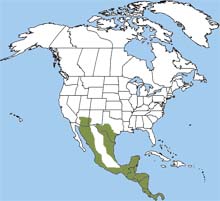 The collared peccary can be found in southeastern Arizona, extreme southeastern and southwestern New Mexico and southwest Texas south to Argentina. The collared peccary can be found in southeastern Arizona, extreme southeastern and southwestern New Mexico and southwest Texas south to Argentina.
Habitat
The collared peccary lives in brushy desert areas and rocky canyons. It is usually found near a water source.
Diet
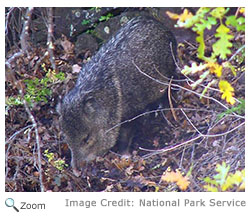 The collared peccary travels in herds looking for food like fruit, nuts, berries, cacti and grass. It will also root in the ground for fungi, roots and bulbs. Occasionally it will eat insects. reptiles and amphibians. It is especially fond of agave and prickly pear. In fact, it gets some of the water it needs from the prickly pear. The collared peccary travels in herds looking for food like fruit, nuts, berries, cacti and grass. It will also root in the ground for fungi, roots and bulbs. Occasionally it will eat insects. reptiles and amphibians. It is especially fond of agave and prickly pear. In fact, it gets some of the water it needs from the prickly pear.
|
|
Life Cycle
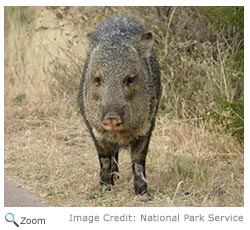 The collared peccary lives in herds of between 6-30 individuals. The dominant male of the herd will mate with the females as they come into heat. If more than one female comes into heat at the same time, a subordinate male may mate with her. The collared peccary lives in herds of between 6-30 individuals. The dominant male of the herd will mate with the females as they come into heat. If more than one female comes into heat at the same time, a subordinate male may mate with her.
 The collared peccary breeds throughout the year. The gestation period is 21 weeks. The female gives birth in dens in a hollow log or in a depression in the ground. She has to two to six young, but the average litter size is two. The young can travel with the herd a day after birth. They are weaned when they are two or three months old. The collared peccary breeds throughout the year. The gestation period is 21 weeks. The female gives birth in dens in a hollow log or in a depression in the ground. She has to two to six young, but the average litter size is two. The young can travel with the herd a day after birth. They are weaned when they are two or three months old.
Behavior
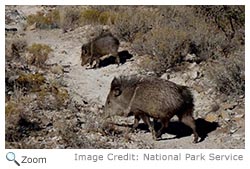 In the summer, the collared peccary is active at night when the temperatures are cooler. In theheat of the day, it will bed down in the shade under a bush or boulders or in a cave to stay cool. In the winter, it is more active in the day. It often beds down with other peccaries to stay warm.
The peccary is territorial and members of the group will defend their territory from other peccaries. A peccary will warn off an intruder by laying back its ears and chattering its teeth. If that doesn't work, it may charge head first at the intruder and bite it or even lock jaws with it.
|